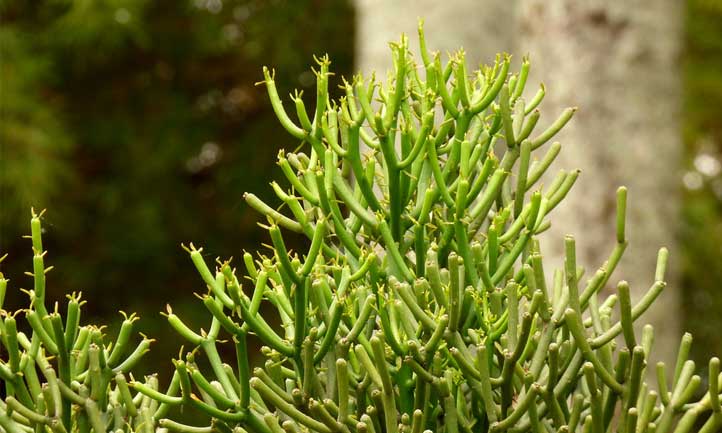Pencil Cactus Care: A Guide to Growing Firesticks
If you’re on the lookout for a stunning succulent for your space, consider the pencil cactus, also known as Euphorbia tirucalli, which can be grown both indoors as a houseplant and outdoors as an ornamental plant. Discover how to cultivate these vibrant and fiery “firesticks” with our comprehensive guide!
The pencil cactus boasts several intriguing names like aveloz, firestick plant, Indian tree spurge, naked lady, and milkbush. Be cautious as it releases a toxic white sap when injured, but with care, you can cultivate and enjoy this unique plant.
Pencil Cactus Quick Care Guide

| Scientific Name | Euphorbia tirucalli |
| Common Name(s) | Pencil cactus, aveloz, Indian tree spurge, naked lady, pencil tree, pencil plant, and milk bush |
| Family | Euphorbiaceae |
| Height & Spread | Can reach up to 30 feet in height |
| Sun | Full, bright sun all day |
| Soil | Requires well-draining, gritty soil |
| Water | Low water needs |
| Pests & Diseases | May be susceptible to root rot, phomopsis, spider mites, mealybugs, aphids |
All About the Pencil Cactus
Belonging to the Euphorbia family, the pencil cactus is a versatile plant that adapts to various indoor settings. In its natural habitat, it can grow up to impressive heights. The stems of the E. tirucalli ‘Sticks on Fire’ are vertical with loose branching, resembling thin, colorful pencils. With the right conditions, this firestick plant can thrive indoors, growing up to several feet wide with its vibrant hues.
Despite its name, the pencil cactus is not a true cactus but a succulent. Its leaves, which appear briefly and then fall off, contribute to its unique appearance. The stems of Euphorbia plants, including the pencil cactus, are actually modified thorns, a characteristic shared with other Euphorbias like the Christmas, Easter, and Thanksgiving cacti.
Aside from being an eye-catching houseplant, the Euphorbia tirucalli has commercial applications. Its hydrocarbon-rich latex can be utilized for various purposes, such as an alternative fuel source or in rubber production. This resilient plant can thrive in poor soil conditions, making it a valuable addition to a garden or landscape.
Native to Africa and India, the pencil cactus thrives in arid regions with low humidity, often serving as fodder for livestock in certain areas. While visually appealing, it’s essential to note that the plant’s milky sap is toxic to animals and humans, necessitating caution when handling or planting it.
Pencil Cactus Care

The firestick plant is relatively low-maintenance, requiring minimal attention to soil, watering, and fertilization.
Light
For optimal growth, the pencil cactus needs abundant sunlight, preferably at least six hours daily. Indoors, position it near a sunlit south-facing window for best results. Maintain temperatures between 65°F to 70°F, protecting it from temperatures below 50°. While it tolerates heat well, ensure it avoids cold drafts.
Water
As a succulent, the pencil cactus stores water in its stems and leaves, requiring infrequent watering. In summer, water it every 2-3 weeks when the topsoil dries out, reducing watering to once a month in winter. During colder periods, minimal watering is necessary.
Soil
When growing pencil cacti indoors, use well-draining, gritty soil to prevent root rot. Adequate drainage is crucial to avoid waterlogged conditions that can harm the plant. Opt for a cactus-specific soil mix or create your own using coarse materials and peat moss.
Fertilizing Your Pencil Cactus
For healthy growth, it’s recommended to fertilize your pencil cactus appropriately. Stick plants can benefit from a controlled-release fertilizer at the beginning of the growing season. Alternatively, you can opt for a weak liquid solution applied weekly. While a balanced 20-20-20 fertilizer diluted to one-quarter strength is suitable for large outdoor plants, a 6-4-6 fertilizer should suffice for most soils. Remember to avoid fertilizing your pencil cactus during the fall and winter months when it’s dormant.
Propagating Your Pencil Cactus
If you wish to propagate your Euphorbia firesticks, it’s a straightforward process. Utilize cuttings from healthy stems, ensuring they develop tiny roots. Exercise caution and wear appropriate protective gear when handling the cactus. Before planting the stem cuttings in fresh cactus mix, allow them to dry out adequately to prevent rotting in the soil. Lightly water the cuttings and refrain from further watering until the top layers of the soil dry out, usually within a month when roots and new growth begin to form.
Repotting Your Pencil Cactus
Consider repotting your pencil cactus every one to two years to ensure its continued well-being. Opt for a slightly larger pot with adequate drainage holes to accommodate the cactus’s root ball. Carefully transfer the plant, gently separating the roots, into fresh cactus soil. Provide a light watering after repotting.
Maintaining Your Pencil Cactus
While minimal pruning is required for stick cacti, occasionally trimming overgrown branches can help maintain a desirable shape. Note that the cactus sap is toxic, so ensure you wear protective gear and avoid direct contact with the sap.
Identifying and Addressing Problems


While pencil cacti are usually resilient, they may encounter issues such as overwatering, light deficiency, diseases like Phomopsis, root rot, and pests such as aphids and mealybugs. Let’s delve into recognizing and resolving these potential concerns.
FAQs about Pencil Cacti








